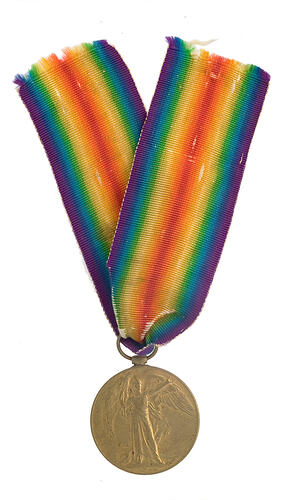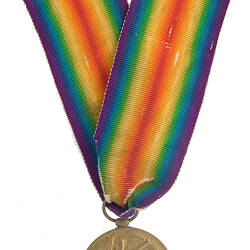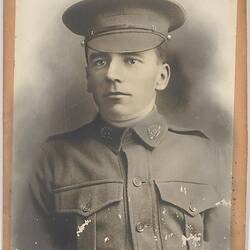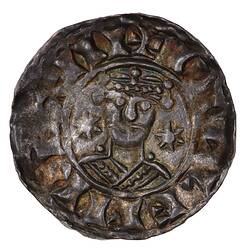Summary
This Victory medal was awarded posthumously to Private Albert Edward Kemp, service number 6800, 6th Battalion, 22nd Reinforcements, of the A.I.F. He was killed in action in Belgium on the 21st September 1917, during World War I.
The Victory Medal was authorised in 1919 and was awarded to army, navy and air force personnel who served in a theatre of war between midnight 4-5 August 1914 and midnight 11-12 November 1918. The Allies resolved that, if they wished to issue a Victory Medal, it would share a common feature of a depiction of Victory on the obverse and a ribbon of red, yellow, green, blue and violet merged into a rainbow pattern. This medal, that of Great Britain, was awarded to personnel from countries in the British Empire (some 5,725,000 were issued). The other Allied countries that issued Victory medals were: Belgium, Brazil, Cuba, Czechoslovakia, France, Greece, Italy, Japan, Portugal, Romania, Thailand, Union of South Africa and the United States of America.
Obverse Description
A figure of Victory facing three-quarters right with wings spread; in her right hand she holds a palm branch, her left hand is extended and open. The artist's initials, W.McM. (W. McMillan) are above the ground line on the right.
Reverse Description
The words, THE GREAT . WAR FOR . CIVILISATION 1914 - 1919 within a circular wreath of laurel.
Edge Description
6800 PTE A.E. KEMP 6 BN. A.I.F.
Significance
Private Albert Kemp, 6th Battalion, 22nd Reinforcements, 6800, was born in South Yarra. He enlisted at Royal Park on 14 October 1916. His occupation was listed as Butcher. He was married to Annie Josephine Kemp of 8 Normanby Avenue , Malvern. They had a daughter Ethel. Embarked from Melbourne, 25 October 1916 on HMAT Ulysses. Private Kemp was killed in action in Belgium 21 September 1917. In the National Archives of Australia there are 52 pages of digitized material relating to Private Kemp. See narrative record Albert Edward Kemp.
More Information
-
Collection Names
-
Collecting Areas
-
Acquisition Information
Purchase from Mr Jeff Kemp, 07 Dec 2006
-
Issued By
-
Artist
-
Awarded To
Private Albert E. Kemp - 6th Battalion, Australian Imperial Force (AIF), Malvern, Greater Melbourne, Victoria, Australia, 1919
6800 Pte A.E. Kemp, 6th Battalion, A.I.F. -
Material
Bronze
-
Axis
12
-
Classification
-
Category
-
Discipline
-
Type of item
-
Diameter
50 mm (Height), 36 mm (Outside Diameter)
Height to top of loop
-
Overall Dimensions
150 mm (Length), 38 mm (Width), 4 mm (Height)
-
Shape
Round with loop and ribbon
-
References
[Book] Hutchinson, Garrie. 2009. Remember Them; a Guide to Victoria's Wartime Heritage., 30-2 Pages
-
Keywords
Victory Medals, Wars & Conflicts, World War I, 1914-1918, Making History - Kemp Mourning Collection







